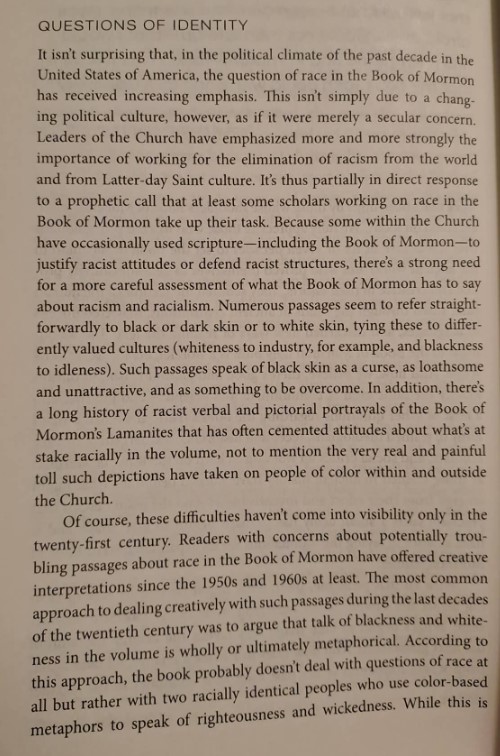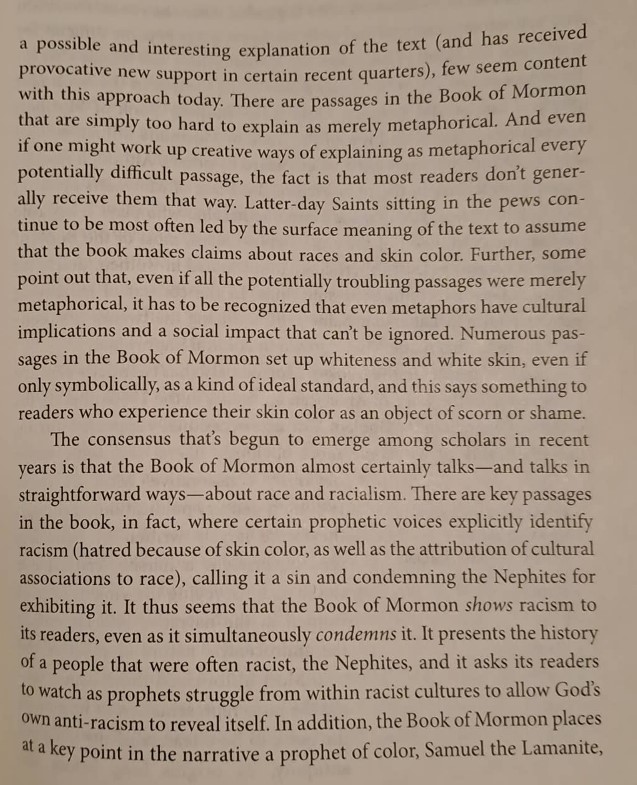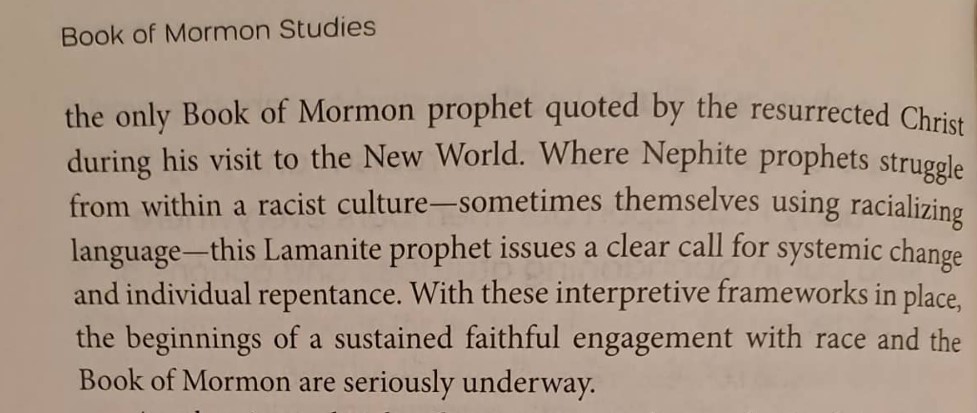Daniel Becerra et al. give an overview of the interpretation of black/white skins in the Book of Mormon; argues there are problems with a purely metaphorical approach.
- Type
- Book
- Source
- Daniel Becerra LDS
- Hearsay
- Direct
- Reference
Daniel Becerra, Amy Easton-Flake, Nicholas J. Frederick, and Joseph M. Spencer, Book of Mormon Studies: An Introduction and Guide (Provo, UT: Religious Studies Center; Salt Lake City, UT: Deseret Book, 2022), 114-16
- Scribe/Publisher
- BYU Religious Studies Center, Deseret Book
- Audience
- Reading Public
- Transcription
QUESTIONS OF IDENITTY
It isn’t surprising that, in the political climate of the past decade in the United States of America, the question of race in the Book of Mormon has received increasing emphasis. This isn’t simply due to a changing political culture, however, as if it were merely a secular concern. Leaders of the Church have emphasized more and more strongly the importance of working for the elimination of racism from the world and from Latter-day Saint culture. It’s thus partially in direct response to a prophetic call that at least some scholars working on race in the Book of Mormon take up their task. Because some within the Church have occasionally used scripture—including the Book of Mormon—to justify racist attitudes or defend racist structures, there’s a strong need for a more careful assessment of what the Book of Mormon has to say about racism and racialism. Numerous passages seem to refer straight-forwardly to black or dark skin or to white skin, tying these to differently valued cultures (whiteness to industry, for example, and blackness to idleness). Such passages speak of black skin as a curse, as loathsome and unattractive, and as something to be overcome. In addition, there’s a long history of racist verbal and pictorial portrayals of the Book of Mormon’s Lamanites that has often cemented attitudes about what’s at stake racially in the volume, not to mention the very real and painful toll such depictions have taken on people of color within and outside of the Church.
Of course, these difficulties haven’t some into visibility only in the twenty-first century. Readers with concerns about potentially troubling passages about race in the Book of Mormon have offered creative interpretations since the 1950s and 1960s at least. The most common approach to dealing creatively with such passages during the last decades of the twentieth century was to argue that talk of blackness and whiteness in the volume is wholly or ultimately metaphorical. According to this approach, the book probably doesn’t deal with questions of race at all but rather with two racially identical peoples who use color-based metaphors to speak of righteousness and wickedness. While this is a possible and interesting explanation of the text (and has received provocative new support in certain recent quarters), few seem content with this approach today. There are passages in the Book of Mormon that are simply to hard to explain as merely metaphorical. And even if one might work up creative ways of explaining as metaphorical every potentially difficult passage, the fact is that most readers don’t generally receive them that way. Latter-day Saints sitting in the pews continue to be most often led by the surface meaning of the text to assume that the book males claims about races and skin color. Further, some point out that, even if all the potentially troubling passages were merely metaphorical, it has to be recognized that even metaphors have cultural implications and a social impact that can’t be ignored. Numerous passages in the Book of Mormon set up whiteness and white skin, even if only symbolically, as a kind of ideal standard, and this says something to readers who experience their skin color as an object of scorn or shame.
The consensus that’s begun to emerge among scholars in recent years is that the Book of Mormon almost certainly talks—and talks in straightforward ways—about race and racialism. There are key passages in the book, in fact, where certain prophetic voices explicitly identify racism (hatred because of skin color, as well as the attribution of cultural associations to race), calling it a sin and condemning the Nephites for exhibiting it. It thus seems that the Book of Mormon shows racism to its readers, even as it simultaneously condemns it. It presents the history of a people that were often racist, the Nephites, and it asks its readers to watch as prophets struggle from within racist cultures to allow God’s own anti-racism to reveal itself. In addition, the Book of Mormon places at a key point in the narrative a prophet of color, Samuel the Lamanite, the only Book of Mormon prophet quoted by the resurrected Christ during his visit to the New World. Where Nephite prophets struggle from within a racist culture—sometimes themselves using racializing language—this Lamanite prophet issues a clear call for systemic change and individual repentance. With these interpretive frameworks in place, the beginnings of a sustain faithful engagement with race and the Book of Mormon are seriously underway.
- Citations in Mormonr Qnas
The B. H. Roberts Foundation is not owned by, operated by, or affiliated with the Church of Jesus Christ of Latter-day Saints.



